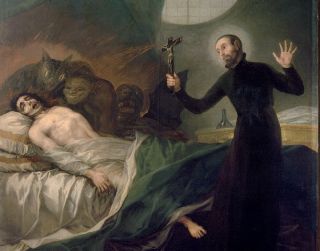Psychosis
A Differential Diagnosis of Demonic Possession
Psychological explanations for an enduring phenomenon that may be on the rise.
Updated December 5, 2023 Reviewed by Vanessa Lancaster
Key points
- Nearly half the population believes in possession, with some evidence that purported cases are on the rise.
- A differential diagnosis of possession reveals several possibilities beyond "real" vs. "delusional."
- Identifying the most likely cause of possession experiences is the key to getting the right help.

The idea that humans can be “possessed” by the devil, demons, or spirits has been an enduring cultural meme for millennia, if not since the dawn of civilization. Although possession beliefs have been in relative decline over the past century, coincident with a decline in religious belief, polls from the past decade tell us that about 40-50 percent of the population still believes in demonic possession.1,2 And there is some evidence that cases of purported possession have been on the rise in recent years.3
That said, there’s a crucial difference between beliefs about what might be and beliefs about what is, just as there’s a crucial difference between what we believe is generally going on in the world and what’s happening to us. Indeed, these differences in conviction and self-referentiality often serve as a dividing line separating shared cultural beliefs and, therefore, normal from idiosyncratic and pathological delusions. So it is those beliefs about the possibility of a Second Coming of Christ, mass surveillance by the government, and alien abductions that are part of popular religious doctrine and cultural mythology, while the insistence that you are the Messiah, that the government is surveilling you, or that aliens abducted you would be good cause to suspect delusional thinking.
Still, the phenomenon of spirit possession is hardly a black-and-white question of normal vs. pathological. There’s plenty of room in between to offer other explanations for different kinds of possession experiences and associated beliefs. In this post, I’ll briefly overview some psychological explanations of spirit possession to generate what doctors call a “differential diagnosis.”
Actual possession?
Bearing in mind that nearly half the population believes that possession is a real thing, intellectual humility dictates that we at least entertain the possibility that demons and devils really exist and that they can inhabit the bodies of people and take control. Indeed, demands for exorcism have been on the rise in recent years, both among Catholics for whom exorcism remains a sanctioned ritual and among non-Catholics.4
However, if we acknowledge this possibility, we should also acknowledge that there’s no real evidence to support it, despite what anyone believes. We should also recognize that similar beliefs about possession have contributed to the age-old gruesome practice of trepanation (drilling holes in the skull to release "bad spirits") as well as the persecution and murder of the many thousands who have been accused of witchcraft right up to the present day.5 Likewise, several cases of death from exorcism have made newspaper headlines over the years, including that of Annaliese Michael in the 1970s and a three-year-old girl as recently as 2022.6 These deaths by exorcism appropriately resulted in charges of negligent homicide and felony child abuse.
Trance, dissociation, and ritual enactment
As with Catholic exorcism, spirit possession is a component of religious and other cultural rituals throughout the world, ranging from seances and the practice of “speaking in tongues” in the U.S. to the voodoo of Haiti and the sanghyang of Indonesia. Psychiatry has often attributed this culturally sanctioned possession experience as a “ritualized trance state” or “dissociation” with the potential overlap between the two altered states of consciousness.7 Such mental states can be understood as at least partially voluntary, where—similar to being hypnotized—both suggestibility and a willingness to enact the role of a possessed individual are core elements of the ritualized experience.
Note that “enact” refers to behavior ranging from deliberate acting to much less deliberate or conscious effort. In a recent post, I used the same term to describe the phenomenon of dissociative identity disorder and related variants such as “tulpamancy.” Indeed, dissociative identity disorder has also been invoked to account for some cases of demonic possession.8
Mass hysteria
It has long been recognized that outbreaks of group behavior attributed to demonic possession or witchcraft—manifested through fits, convulsions, and various vocal utterances—can be explained by the phenomenon of “mass hysteria,” “mass psychogenic illness,” or “mass sociogenic illness.”9 As with trance rituals, mass psychogenic illness involves a core component of suggestibility but within a different context. Instead of being part of a confined group ritual where the behavior is sanctioned, it arises seemingly randomly within the general public, often in response to cultural panic.
The classic pattern of mass psychogenic illness begins with public fear about something like a contaminant in the environment that leads to individuals developing unusual symptoms and behaviors, with that individual reaction spreading to others like a contagion but without any actual evidence of exposure or other physical explanation. Modeled as a type of “conversion disorder,” this psychological response occurs as a largely unconscious process so that those affected aren’t simply “doing it on purpose” or “faking it,” although that is another possibility.
It has been argued that mass psychogenic illness offers the best explanation for the Salem witch trials, whereby the “witches” succumbed to suggestions and accusations of witchcraft.10 While cases of demonic possession due to mass psychogenic illness were also quite common throughout the Middle Ages, modern instances of mass psychogenic illness are more likely to reflect contemporary fears about technology and chemical exposure, such as improbable “microwave attacks” and toxic airborne exposure to fentanyl.
Still, given the widespread belief in possession, it’s completely possible that mass psychogenic illness could still result in outbreaks of alleged demonic possession today. One noteworthy instance was described in Malaysia in the 1970s just as cases of demonic possession coincidentally spiked here in the US following the release of the movie The Exorcist in 1973.11 Worldwide cases of purported possession and associated requests for exorcisms have also seemed to spike since the pandemic.3
Psychosis and delusion
It’s not unusual for people with psychotic disorders to have the delusional belief that the devil or demons possess them. While such a belief can be thought of as an example of psychosis in itself, the late Harvard psychologist Brendan Maher proposed that delusional beliefs are merely reasonable explanations for “anomalous experiences.”12 According to this “one-factor” view of delusions, it is not the belief in possession that is pathological so much as the anomalous experience that provides the subjective evidence for the delusional belief.
For people with psychotic disorders like schizophrenia, this evidence often takes the form of auditory hallucinations or “hearing voices,” including that of the devil or demons. In addition, people with schizophrenia may also experience a “loss of agency” whereby their thoughts and actions seem foreign as if it’s not them but someone else thinking, speaking, or moving their body. Such experiences are overrepresented among those with delusions of possession.13 But psychotic experiences like this are not always due to psychotic disorders like schizophrenia per se—they can also occur in the setting of many other medical or psychiatric conditions.
I recently worked with two patients who developed delusions of demonic possession in the context of such experiences. Neither had a history of psychosis, were particularly religious, or had previously given much thought to the phenomenon of possession. One came to be convinced that she was possessed during a manic episode when she heard the devil speaking to her and had the urge to strike out at someone or utter racial epithets despite not wanting to do so. The other developed a profound and unpleasant loss of agency following a bout of encephalitis, or brain inflammation, due to COVID that he believed had to be caused by demonic possession. "There must be some way to get 'it' out," he pleaded.
Curiously, a recent case report of spirit possession in the medical literature described evidence of a structural abnormality in a part of a patient's brain called the basal ganglia and a real-time association with his possession experience and lack of blood flow to his temporal lobe.14 Other cases of demonic possession—including that of Anneliese Michael—have also been attributed to epilepsy. Such associations suggest that some cases of spirit possession may have neurological correlates—and potential biological causes.
Conclusion
Despite the overall decline in possession beliefs in modern times, there is some evidence that cases of purported demonic possession have been on the rise in recent years.11 While nearly half of the population might attribute this to actual possession, there are several other potential psychological explanations for believing that one is possessed. Like any medical diagnosis, determining the best explanation for individual cases—beyond the reductionist dichotomy of "real" or "delusional"—is essential for determining whether intervention is warranted and, if so, what intervention might be most helpful.
To find a therapist, visit the Psychology Today Therapy Directory.
References
1. Green E. A lot of Americans think the spirit world exists. The Atlantic; May 7, 2014.
2. Jagel K. Half of Americans believe in possession by the Devil. Today.YouGov.com; September 17, 2013. https://today.yougov.com/topics/society/articles-reports/2013/09/17/hal…
3. Squires N. Pandemic boosts demand for exorcisms as people fall prey to 'malign forces' and poverty. The Telegraph. October 25, 2021.
4. Kingsbury K, Chestnut A. Driving out the Devil: what’s behind the exorcism boom? The Catholic Herald; January 10, 2019.
5. Wikipedia. Witch-hunt.
6. Traub A. Relatives charged in the exorcism death of a 3-year old girl. The New York Times; May 18, 2022.
7. McCormick S, Goff DC. Possession states: approaches to clinical evaluation and classification. Behavioural Neurology 1992; 5: 161-167.
8. Kenny MG. Multiple personality and spirit possession. Psychiatry 1981; 44: 337-358.
9. Bartholomew RE, Wessely S. Protean nature of mass sociogenic illness. British Journal of Psychiatry 2002; 180: 300-306.
10. DeCosta-Klipa N. The theory that may explain what was tormenting the affilicted in Salem’s witch trials. Boston.com; October 31, 2017.
11. Ong A. The production of possession: Spirits and the multinational corporation in Malaysia. American Ethnologist 1988; 15:28-42.
12. Sakakibara E. Intensity of experience: Maher’s theory of schizophrenic delusion revisited. Neuroethics 2019; 12:171-182.
13. Goff DC, Brotman AW, Kindlon D, Waites M, Amico E. The delusion of possession in chronically psychotic patients. The Journal of Nervous and Mental Disease 1991; 179:567-571.
14. Guenedi AA, Al Hussaini A, Obeid YA, Hussain S, Al-Azri F, Al-Adawi S. Investigation of the cerebral blood flow of an Omani man with supposed 'spirit posession' associated with an altered mental state: a case report. Journal of Medical Case Reports 2009; 3:9325.




